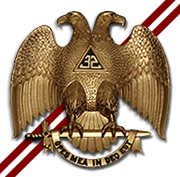

Stratton Duluth Brooks, 33°
(Sep 9, 1869-Jan 18, 1949)
Member Norman Lodge #38, Norman, Oklahoma
Member, Acacia Lodge #602
1924 - 32° Consistory of Western Missouri, Kansas City
Knight Commander, Court of Honour
1927 - Coroneted 33° Inspector General Honorary
1923 - Columbia, MO Chapter #17, R.A.M.
1924 - St. Graal Commandery #12, K.T.
Occupation: President of the University of Missouri, Columbia, MO
Alumnus: University of Michigan, Harvard University
Recommended: John Piccard, KC Sullivan.
Interred: IOOF Cemetery, Norman, Oklahoma.
Brother Stratton Brooks (Sep 10, 1870-Jan 18, 1949) was the third president of the University of Oklahoma and eleventh president of the University of Missouri.
Stratton Brooks was born in 1870 in Everett, Missouri. At the age of two, he and his parents moved to Michigan where his father, Charles Brooks, was a Sheriff in Isabella Co. Michigan. Stratton Brooks graduated from Mt. Pleasant High School, Mt. Pleasant, Michigan class of 1887. Brooks was educated at the University of Michigan and held a master's degree from Harvard University. Prior to being appointed president of the University of Oklahoma, he had been superintendent of Boston public schools.
University of Oklahoma
When Brooks was first being courted for the position of OU president in 1911, he at first declined the position. It was seen as a fledging university. He was approached again in 1912 while at a national superintendent's meetings in St. Louis, Missouri. Eventually, Brooks accepted the position later in 1912. At the university, Brooks established a permanent faculty salary, sabbatical leave and permanent tenure. He also acquired land around the university where the stadium and armory now stand. Brooks had a great reputation with the Board of Education (now the Board of Regents) and the Oklahoma legislature. During his years as president, many building were constructed around campus.
Brooks' was also OU's first wartime president, have served during the duration of World War I. He made many efforts to see that the university was at the forefront of preparedness for all war needs. He imposed strict food regulations on the university and he established thirteen courses in seven different departments for the direct purpose of "training soldiers, training men who expect to become soldiers, and training people who take the place of soldiers in civil life." Some of these courses included: wire telegraphy, wireless telegraphy, stenography and shorthand, oxyacetylene welding, orthopedic surgery, military field engineering, and first aid courses. Students under 21 were required to take special courses in the Student Army Training Corps. Barracks, an infirmary, bathhouse, guardhouse, and canteen were constructed. By the latter part of 1918, the university was practically a military base. All in all, 30 faculty members, 500 alumni, and 1,875 students were in military service during the war.
University of Missouri
Brooks held his job as OU president until 1923 when he accepted a job as the president of the University of Missouri, a job he held until 1931.

